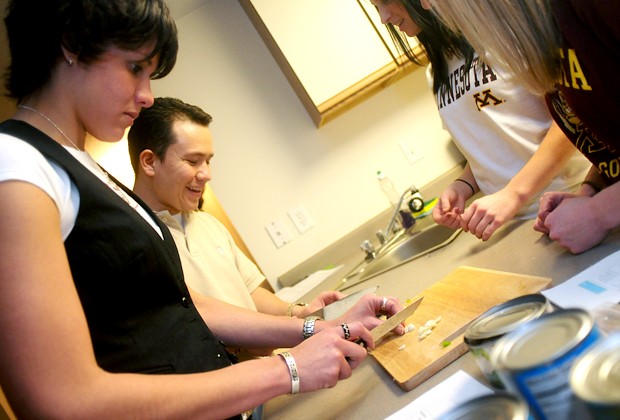This article originally incorrectly attributed a quote about eating Chipotle frequently. Oscar Garzon listed Chiptole as a fast-food option he eats, not Martin Costanian, and the story has been updated to reflect that. Oscar Garzon didnâÄôt even own measuring spoons. So he and his friends, and fellow MBA students Martin Costanian and Pura Mendez , just estimated the measurements for the chili their peer nutrition educators were teaching them to cook Tuesday night. Garzon responded to a notice from Boynton Health ServiceâÄôs nutritionist looking for students who wished to learn how to plan and cook healthy meals at home, and two senior nutrition students came to his apartment as part of a pilot program, which Boynton believes is the first of its kind. Eating out from restaurants, the made-to-order café on the main floor of the apartment building and frozen meals have made up the majority of the trioâÄôs eating since they came to the States last fall from Colombia, Uruguay and the Dominican Republic, respectively. College is the time when people develop most of their eating and cooking habits âÄî for better or for worse, Boynton Health Service nutritionist Christine Twait said, so itâÄôs important to try to help students develop the best habits possible while theyâÄôre still young. âÄúPeople will experiment with diets, try being vegetarian, try vegan; thatâÄôs what youâÄôre supposed to do in your late adolescence, decide who you are,âÄù she said. The idea for the in-home peer nutrition sessions was the brain child of a student working on her MasterâÄôs of Public Health, Twait said. The student had the time to develop the curriculum, and Twait had eight nutrition interns looking for the opportunity to use their skills. For most students, eating healthy is more about losing weight and looking good, Twait said. âÄúChronic diseases like heart disease, stroke, diabetes arenâÄôt even on their radar,âÄù she said. Lindsay Frank and April Rose were the two interns who went to GarzonâÄôs apartment Tuesday night, armed with the ingredients for chicken chili and a booklet with ideas for meal planning, grocery lists and simple recipes. âÄúYouâÄôre just conditioned to eating a lot at one time,âÄù Frank said of fast-food portions, which so many students rely on for regular meals. Although the friends have discussed wanting to eat healthier, âÄúwe donâÄôt cook,âÄù Costanian said, laughing. Garzon mentioned Chipotle as one of the fast-food chains he sometimes eats at, which can pack as many as 1,300 calories into a single burrito. For instance, he said someone at a restaurant once told him food didnâÄôt keep past the first day. So learning about leftovers, and how to safely reheat them, was key for him. Frank and Rose, both nutrition seniors, walked the trio through the recipe, offering demonstrations on how to chop the vegetables and rinse the canned beans. âÄúIn moderation,âÄù was a phrase Frank used often as she and Rose taught the others about the foods already in the cupboards. âÄúThe most important thing to understand is about the habits we need to acquire,âÄù Garzon said. âÄúEating out isnâÄôt the only option to have food.âÄù And all three smiled into their steamy bowls of chili and admitted learning to cook was easier than they expected. The next meal on their list? âÄúThe easy pineapple chicken,âÄù Costanian eagerly said. — Emma L. Carew is a senior staff reporter

Image by Chris Roberts
MBA students Pura Mendez, left, and Oscar Garzon worked with nutrition students to learn healthier cooking skills at the Melrose Apartments.
Peer nutritionists teach students to cook
The program is a Boynton pilot.
Published March 3, 2009
0

